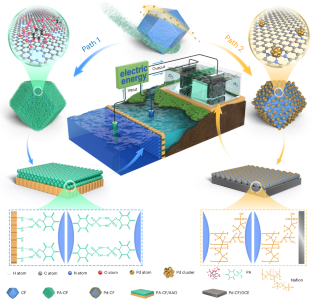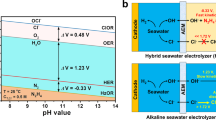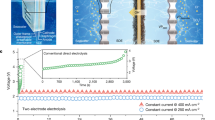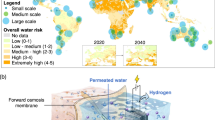Abstract
Hydrogen, a clean energy carrier, has emerged as a promising solution to decarbonize the power sector and move towards a more sustainable future. However, the heavy dependence of its production on fossil fuels highlights the pressing need to prioritize the acquisition of green hydrogen from renewable sources, ideally without any additional energy input. Here we utilize the osmotic energy between seawater and freshwater to generate hydrogen directly. With a tandem of high-performance ion exchange membrane and electrocatalytic electrode, our design serves to harvest osmotic energy and drive hydrogen production. Notably, the integrated device demonstrates a consistent alkaline hydrogen evolution rate exceeding 300 l m−2 h−1 for more than 12 days under the artificial salinity gradient. Our study presents a viable pathway for hydrogen production through renewable sources.
This is a preview of subscription content, access via your institution
Access options
Access Nature and 54 other Nature Portfolio journals
Get Nature+, our best-value online-access subscription
$29.99 / 30 days
cancel any time
Subscribe to this journal
Receive 12 digital issues and online access to articles
$119.00 per year
only $9.92 per issue
Buy this article
- Purchase on Springer Link
- Instant access to full article PDF
Prices may be subject to local taxes which are calculated during checkout





Similar content being viewed by others
Data availability
The Article and its Supplementary Information provide all relevant data substantiating the findings derived from this study. Source data are provided with this paper.
References
Chu, S., Cui, Y. & Liu, N. The path towards sustainable energy. Nat. Mater. 16, 16–22 (2017).
Zhang, X. et al. A large but transient carbon sink from urbanization and rural depopulation in China. Nat. Sustain. 5, 321–328 (2022).
Zhou, M. et al. Environmental benefits and household costs of clean heating options in northern China. Nat. Sustain. 5, 329–338 (2022).
Fedoseeva, S. & Zeidan, R. Tariff reduction on renewables inputs for European decarbonization. Nat. Sustain. 1, 436–440 (2018).
Maugh, T. H. Hydrogen: synthetic fuel of the future. Science 178, 849–852 (1972).
Griffith, E. J. Hydrogen fuel. Nature 248, 458 (1974).
Jacobson, M. Z., Colella, W. G. & Golden, D. M. Cleaning the air and improving health with hydrogen fuel-cell vehicles. Science 308, 1901–1905 (2005).
Staffell, I. et al. The role of hydrogen and fuel cells in the global energy system. Energy Environ. Sci. 12, 463–491 (2019).
Navarro, R. M., Peña, M. A. & Fierro, J. L. G. Hydrogen production reactions from carbon feedstocks: fossil fuels and biomass. Chem. Rev. 107, 3952–3991 (2007).
Glenk, G. & Reichelstein, S. Economics of converting renewable power to hydrogen. Nat. Energy 4, 216–222 (2019).
Christopher, K. & Dimitrios, R. A review on exergy comparison of hydrogen production methods from renewable energy sources. Energy Environ. Sci. 5, 6640–6651 (2012).
Tiwari, J. N. et al. Multi-heteroatom-doped carbon from waste-yeast biomass for sustained water splitting. Nat. Sustain. 3, 556–563 (2020).
Yu, Z.-Y. et al. Clean and affordable hydrogen fuel from alkaline water splitting: past, recent progress, and future prospects. Adv. Mater. 33, 2007100 (2021).
Cai, Z.-X. et al. Tailored catalytic nanoframes from metal-organic frameworks by anisotropic surface modification and etching for the hydrogen evolution reaction. Angew. Chem. Int. Ed. 60, 4747–4755 (2021).
Luo, M. et al. Insights into alloy/oxide or hydroxide interfaces in Ni-Mo-based electrocatalysts for hydrogen evolution under alkaline conditions. Chem. Sci. 14, 3400–3414 (2023).
Tong, W. et al. Electrolysis of low-grade and saline surface water. Nat. Energy 5, 367–377 (2020).
Cârdu, M. & Baica, M. Regarding the greenhouse gas emissions of thermopower plants. Energy Convers. Manage. 43, 2135–2144 (2002).
Cardu, M. & Baica, M. Regarding the relation between the NOx content and CO content in thermo power plants flue gases. Energy Convers. Manage. 46, 47–59 (2005).
Cârdu, M. & Baica, M. On the relation between atmospheric pollution due to thermopower plants and the characteristics of their fuels. Energy Convers. Manage. 44, 1419–1431 (2003).
Veers, P. et al. Grand challenges in the science of wind energy. Science 366, eaau2027 (2019).
Laing, T. Solar power challenges. Nat. Sustain. 5, 285–286 (2022).
van Vliet, M. T. H., Wiberg, D., Leduc, S. & Riahi, K. Power-generation system vulnerability and adaptation to changes in climate and water resources. Nat. Clim. Change 6, 375–380 (2016).
Logan, B. E. & Elimelech, M. Membrane-based processes for sustainable power generation using water. Nature 488, 313–319 (2012).
Siria, A. et al. Giant osmotic energy conversion measured in a single transmembrane boron nitride nanotube. Nature 494, 455–458 (2013).
Lin, C.-Y., Combs, C., Su, Y.-S., Yeh, L.-H. & Siwy, Z. S. Rectification of concentration polarization in mesopores leads to high conductance ionic diodes and high performance osmotic power. J. Am. Chem. Soc. 141, 3691–3698 (2019).
Zhou, Y. & Jiang, L. Bioinspired nanoporous membrane for salinity gradient energy hyarvesting. Joule 4, 2244–2248 (2020).
Xiao, K., Jiang, L. & Antonietti, M. Ion transport in nanofluidic devices for energy harvesting. Joule 3, 2364–2380 (2019).
Zhu, Y., Zhan, K. & Hou, X. Interface design of nanochannels for energy utilization. ACS Nano 12, 908–911 (2018).
Pakulski, D., Czepa, W., Buffa, S. D., Ciesielski, A. & Samorì, P. Atom-thick membranes for water purification and blue energy harvesting. Adv. Funct. Mater. 30, 1902394 (2019).
Troyano, J., Carné-Sánchez, A., Avci, C., Imaz, I. & Maspoch, D. Colloidal metal-organic framework particles: the pioneering case of ZIF-8. Chem. Soc. Rev. 48, 5534–5546 (2019).
Han, A. et al. Recent advances for MOF-derived carbon-supported single-atom catalysts. Small Methods 3, 1800471 (2019).
Liang, Q. et al. General synergistic capture-bonding superassembly of atomically dispersed catalysts on micropore-vacancy frameworks. Nano Lett. 22, 2889–2897 (2022).
Kim, M. et al. MOF-derived nanoporous carbons with diverse tunable nanoarchitectures. Nat. Protoc. 17, 2990–3027 (2022).
Zhang, J. et al. N, P-codoped carbon networks as efficient metal-free bifunctional catalysts for oxygen reduction and hydrogen evolution reactions. Angew. Chem. Int. Ed. 55, 2230–2234 (2016).
Zhang, Z. et al. Improved osmotic energy conversion in heterogeneous membrane boosted by three-dimensional hydrogel interface. Nat. Commun. 11, 875 (2020).
Zhou, S. et al. Pd single-atom catalysts on nitrogen-doped graphene for the highly selective photothermal hydrogenation of acetylene to ethylene. Adv. Mater. 31, e1900509 (2019).
Hou, S. et al. Free-standing covalent organic framework membrane for high-efficiency salinity gradient energy conversion. Angew. Chem. Int. Ed. 60, 9925–9930 (2021).
Rollings, R. C., Kuan, A. T. & Golovchenko, J. A. Ion selectivity of graphene nanopores. Nat. Commun. 7, 11408 (2016).
Huang, Y. et al. Super-assembled chiral mesostructured heteromembranes for smart and sensitive couple-accelerated enantioseparation. J. Am. Chem. Soc. 144, 13794–13805 (2022).
Yang, J. et al. Advancing osmotic power generation by covalent organic framework monolayer. Nat. Nanotechnol. 17, 622–628 (2022).
Liang, Q. et al. Metal-organic frameworks derived reverse-encapsulation Co-NC@Mo2C complex for efficient overall water splitting. Nano Energy 57, 746–752 (2019).
Wen, L., Xu, R., Mi, Y. & Lei, Y. Multiple nanostructures based on anodized aluminium oxide templates. Nat. Nanotechnol. 12, 244–250 (2017).
Zhang, X. et al. Interfacial superassembly of mesoporous titania nanopillar-arrays/alumina oxide heterochannels for light- and pH-responsive smart ion transport. ACS Cent. Sci. 8, 361–369 (2022).
Gao, J. et al. High-performance ionic diode membrane for salinity gradient power generation. J. Am. Chem. Soc. 136, 12265–12272 (2014).
Li, R., Jiang, J., Liu, Q., Xie, Z. & Zhai, J. Hybrid nanochannel membrane based on polymer/MOF for high-performance salinity gradient power generation. Nano Energy 53, 643–649 (2018).
Zhang, Z. et al. A bioinspired multifunctional heterogeneous membrane with ultrahigh ionic rectification and highly efficient selective ionic gating. Adv. Mater. 28, 144–150 (2016).
Acknowledgements
B.K. acknowledges funding from the National Natural Science Foundation of China (21974029, 3022105042), the Yiwu Research Institute Program of Fudan University (20-1-28), the Yantai Science and Technology Innovation Development Plan (No. 2022ZDCX015), and the construction project of Shanghai Key Laboratory of Molecular Imaging (18DZ2260400). We thank O. Terasaki (ShanghaiTech University) for valuable suggestions and comments.
Author information
Authors and Affiliations
Contributions
B.K. conceived the work and directed the project. Q.L. and B.K. designed the experiments and drafted the initial manuscript. Y.H., Y.G. and X.Z. helped with computational calculations. X.H. and H.Z. contributed to experimental data collection and analysis. B.K., L.J., D.Z. and K.L. supervised the research, discussed the results, provided useful suggestions on experiment designs, and helped revise the manuscript.
Corresponding author
Ethics declarations
Competing interests
The authors declare no competing interests.
Peer review
Peer review information
Nature Sustainability thanks Jia Zhu and the other, anonymous, reviewer(s) for their contribution to the peer review of this work.
Additional information
Publisher’s note Springer Nature remains neutral with regard to jurisdictional claims in published maps and institutional affiliations.
Supplementary information
Supplementary Information
Supplementary Figs. 1–56, Notes 1–4 and Tables 1–8.
Source data
Source Data Fig. 2
XPS results, source data.
Source Data Fig. 3
Electrochemical results, source data.
Source Data Fig. 4
Electrochemical results, source data.
Source Data Fig. 5
Simulation parameter, source data.
Rights and permissions
Springer Nature or its licensor (e.g. a society or other partner) holds exclusive rights to this article under a publishing agreement with the author(s) or other rightsholder(s); author self-archiving of the accepted manuscript version of this article is solely governed by the terms of such publishing agreement and applicable law.
About this article
Cite this article
Liang, Q., Huang, Y., Guo, Y. et al. Efficient osmosis-powered production of green hydrogen. Nat Sustain (2024). https://doi.org/10.1038/s41893-024-01317-7
Received:
Accepted:
Published:
DOI: https://doi.org/10.1038/s41893-024-01317-7



